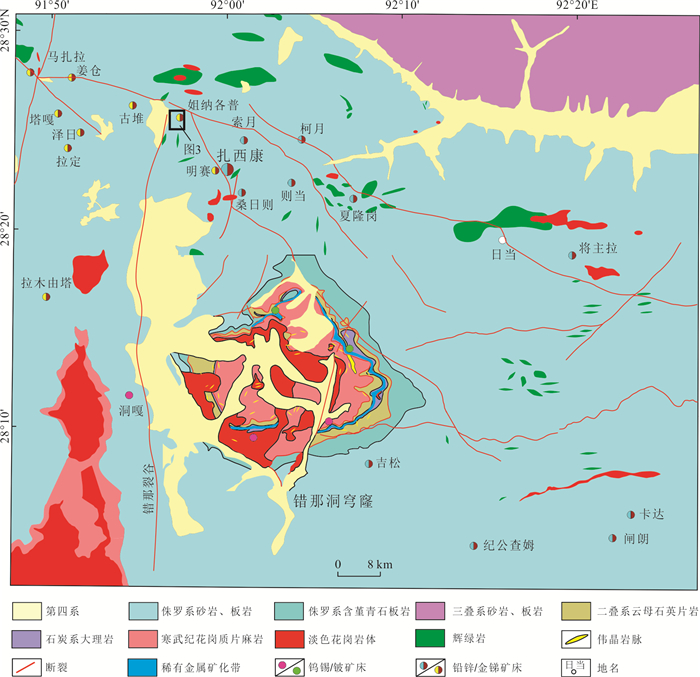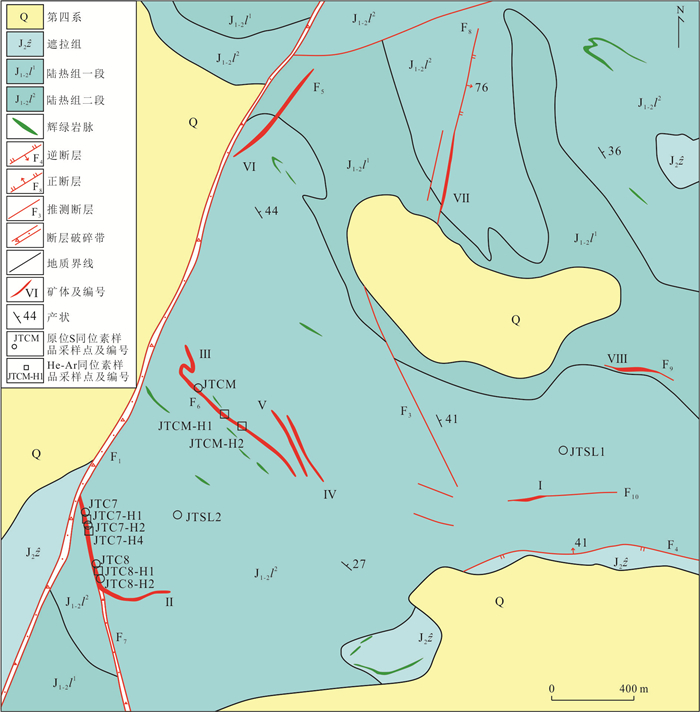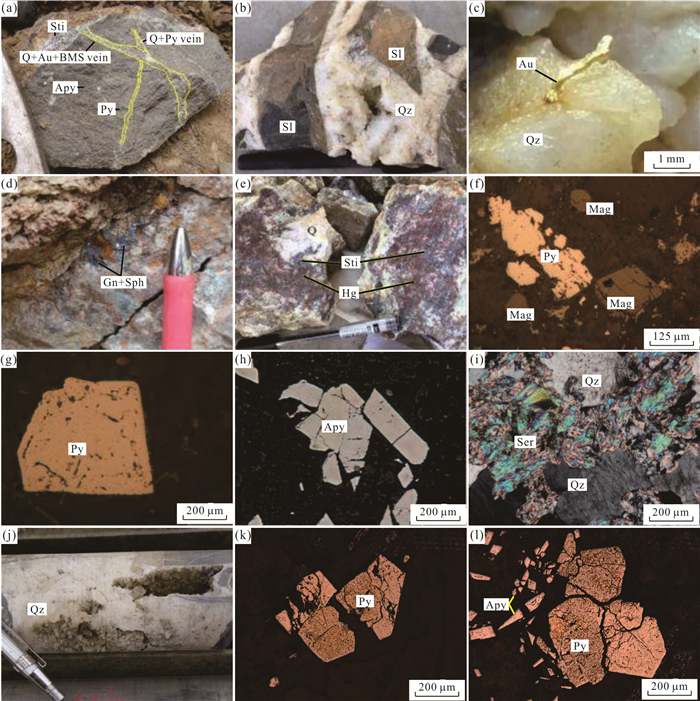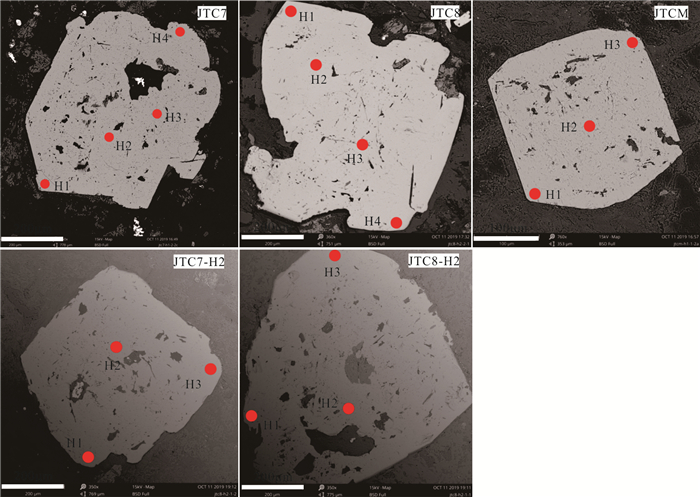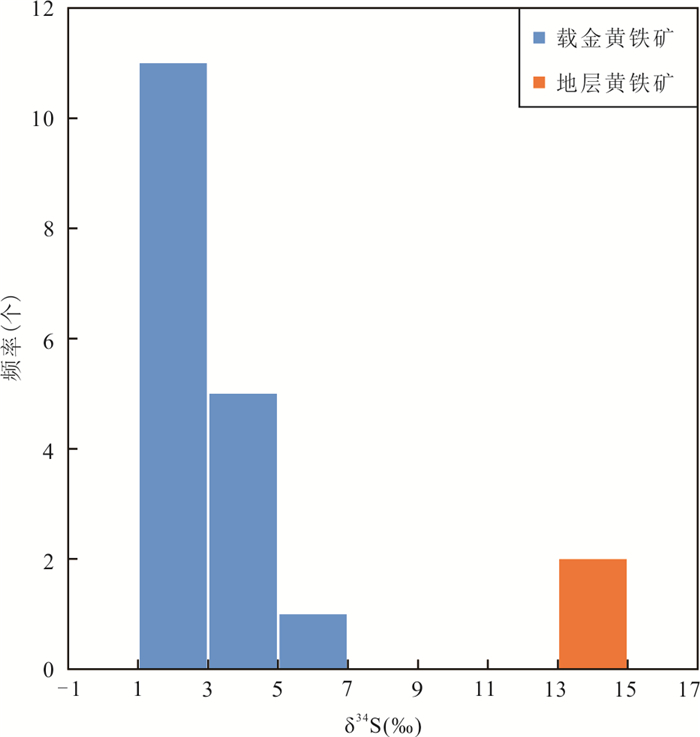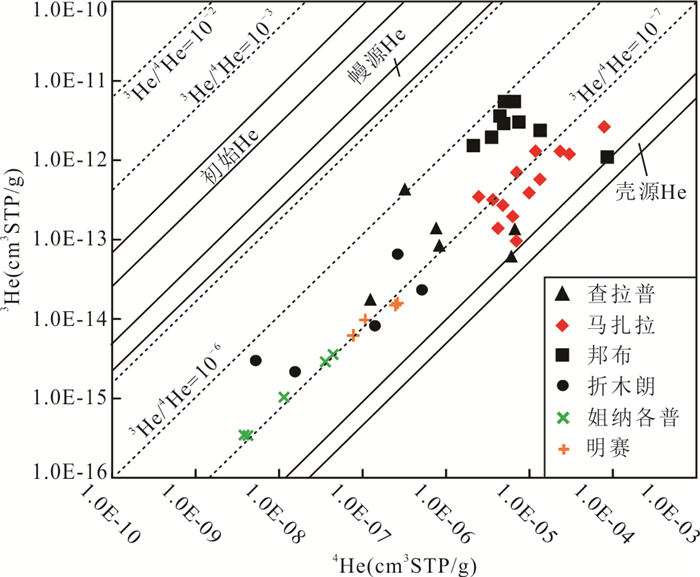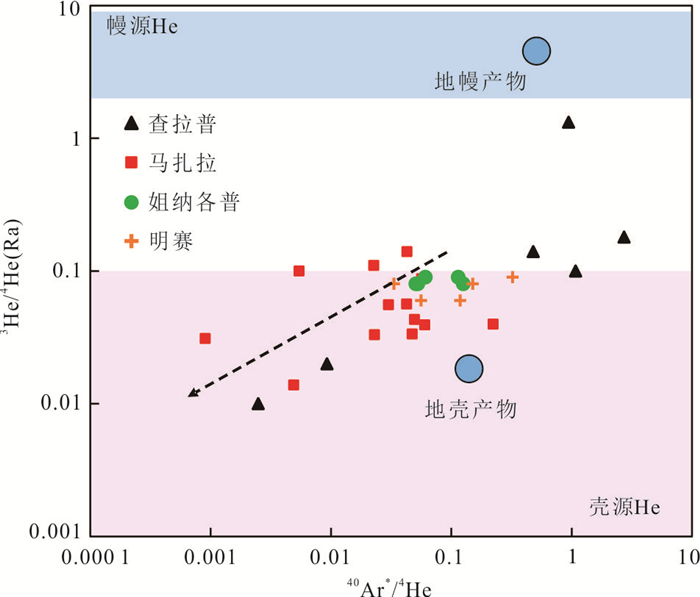Genesis of Jienagepu Gold Deposit in Zhaxikang Ore Concentration Area, Eastern Tethys Himalayas: Constraints from He-Ar and In-Situ S Isotope of Pyrite
-
摘要: 姐纳各普金矿床是特提斯喜马拉雅东段扎西康矿集区内新近发现的中新世热液金矿床,但其成因认识较为模糊.矿体呈层状或似层状,严格受伸展断裂构造控制,具蚀变岩型和石英脉型2种矿石,主要发育硅化、黄铁矿化、绢云母化和方解石化.为厘定矿床成因,对矿床Ⅱ号和Ⅲ号矿体中的蚀变岩型矿石进行了系统采样,分析其黄铁矿He-Ar和原位S同位素组成特征.结果表明:黄铁矿内的4He含量介于0.038×10-7~0.446×10-7 cm3 STP/g,平均含量0.200×10-7 cm3 STP/g;3He/4He比值介于0.08~0.09 Ra,平均比值为0.08 Ra;40Ar含量变化于0.049×10-7~0.132×10-7 cm3 STP/g,平均含量0.084×10-7 cm3 STP/g;40Ar/36Ar比值介于308.0~386.3,平均比值347.1,指示成矿流体主要来自壳源变质流体;黄铁矿δ34S值分布集中,总体变化于1‰~3‰,平均值2.98‰,显示成矿物质来自地壳深部壳幔物质均一化的深源.结合前人研究成果,文章认为姐纳各普金矿床属于造山型金矿床,其成因的厘定对丰富和完善大陆碰撞造山成矿作用理论和指导区域矿床勘查具有重要意义.Abstract: Jienagepu gold deposit is a newly discovered Miocene hydrothermal gold deposit in the Zhaxikang ore concentration area, eastern Tethyan Himalayas, but its genesis is rather vague. The ore body is stratified or approximately stratified, strictly controlled by extensional fault structure. In this study, two types of ores were recognized, namely altered rock type and quartz vein type, with extensive hydrothermal alternation, including silicification, pyritization, sericization and calcite. Samples were systematically taken from the altered rock type ore in orebody No. Ⅱ and No. Ⅲ, and the composition characteristics of He-Ar and in-situ S isotope of pyrite were analyzed to determine the genesis of the deposit. The results show that the content of 4He and 3He/4He ratio in pyrite ranged widely from 0.038×10-7 cm3 STP/g to 0.446×10-7 cm3 STP/g, 0.08 Ra to 0.09 Ra, with an average of 0.200×10-7 cm3 STP/g and 0.08 Ra. The content of 40Ar and 40Ar/36Ar ratio vary from 0.049×10-7 cm3 STP/g to 0.132×10-7 cm3 STP/g, 308.0 to 386.3, with an average of 0.084×10-7 cm3 STP/g and 347.1, indicating that the ore-forming fluid mainly originated from the crustal metamorphic fluid. The δ34S value of pyrite is concentrated, and the overall variation is between 1‰ and 3‰, with an average of 2.98‰, showing that the ore-forming material is from crustal-mantle homogenized deep source. Combined with previous research results, in this paper it holds that Jienagepu gold deposit is an orogenic type gold deposit, and the determination of genesis is of great significance to enrich and perfect the mineralization theory of continental collisional orogeny and to guide the exploration of regional ore deposits.
-
Key words:
- orogenic gold deposit /
- He-Ar isotope /
- in-situ S isotope /
- Jienagepu /
- Zhaxikang ore concentration area /
- Tethys Himalayas /
- deposit
-
图 1 研究区大地构造位置(a)及区域矿床分布图(b)(据杨竹森等,2006修改)
Fig. 1. Geotectonic (a) and regional deposit distribution (b) maps of the study area(modified from Yang et al., 2006)
图 2 扎西康矿集区地质图(据李光明等,2017修改)
Fig. 2. Geological map of Zhaxikang ore concentration area (modified from Li et al., 2017)
图 5 姐纳各普金矿床主要矿石矿物特征
a.蚀变岩型矿石及穿切其中石英-硫化物脉;b.石英脉型矿石中发育的角砾状、晶洞及晶簇构造;c.石英脉型矿石中的自然金;d.方铅矿与闪锌矿集合体;e.石英脉型矿石中的辉锑矿及薄膜状辰砂;f.半自形黄铁矿及磁铁矿颗粒;g.具微弱环带结构的自形粒状黄铁矿颗粒;h.自形板状毒砂颗粒;i.石英脉型矿石中发育的硅化与绢云母化;j.石英脉型矿石中的晶洞、晶簇构造;k.自形粒状黄铁矿颗粒;l.半自形-自形粒状黄铁矿颗粒及自形菱面体、板状毒砂颗粒;Qz.石英;Apy.毒砂;Py.黄铁矿;BMS.贱金属硫化物;Sti.辉锑矿;Gn.方铅矿;Sph.闪锌矿;Hg.辰砂;Mag.磁铁矿;Ser.绢云母
Fig. 5. Main ore mineral characteristics of Jienagepu gold deposit
图 8 姐纳各普金矿床黄铁矿3He-4He图解
底图据Mamyrin and Tolstikhin(1984);查拉普数据张刚阳(2012);马扎拉数据张刚阳(2012)和翟伟等(2018);折木朗数据引自Zhou et al.(2014);邦布数据韦慧晓等(2010)和Sun et al.(2016b);明赛据Zhang et al.(2020)
Fig. 8. 3He-4He diagram of pyrite in Jienaigop gold deposit
图 9 姐纳各普金矿床3He/4He-40Ar/36Ar图解
壳源流体数据引自Andrews(1985);幔源数据引自Stuart et al.(1994b);其他金矿床数据源同图 8
Fig. 9. 3He/4He-40Ar/36Ar diagram of pyrite in Jienagepu gold deposit
图 10 姐纳各普金矿床3He/4He-40Ar*/4He图解
壳源流体数据引自Andrews(1985);幔源数据引自Stuart et al.(1994b);其他金矿床数据源同图 8
Fig. 10. 3He/4He-40Ar*/4He diagram of pyrite in Jienagepu gold deposit
图 11 姐纳各普金矿床S同位素组成
马扎拉数据杨竹森等(2006)、戚学祥等(2008)、张刚阳(2012)、梁维(2014)和谢玉玲等(2019);明赛数据卢柳(2019);查拉普数据张刚阳(2012);念扎数据张雄(2017);邦布数据韦慧晓等(2010);马攸木数据温春齐等(2006)和Jiang et al.(2009)
Fig. 11. S isotopic compositions of the Jienagepu gold deposit
表 1 姐纳各普金矿床主要矿(化)体地质特征
Table 1. Geological characteristics of main ore (mineralized) bodies of Jienagepu gold deposit
矿(化)体编号 位置 矿石工业类型 矿石组构 矿(化)体形态 矿(化)体产状 矿(化)体规模 品位(g/t) 倾向(°) 倾角(°) 走向延伸(m) 厚度(m) Ⅰ 矿区东南 蚀变岩型 碎裂、土状结构;角砾状构造 透镜状 152 72 ~100 1.12~2.16 0.11~9.67 Ⅱ 矿区西南 石英脉型、蚀变岩型 交代、碎裂结构;网脉状、角砾状、及晶洞构造 似层状透镜状 65 20 ~1 000 5.66~22.05 1.05~10.61 Ⅲ 矿区西部 石英脉型、蚀变岩型 交代、碎裂结构;网脉状、角砾状、及晶洞构造 似层状透镜状 57~68 27~43 > 1 000 1.21~3.21 0.98~2.94 Ⅳ 矿区中部 蚀变岩型 碎裂结构;角砾状构造 似层状 64 41 260 1.01~2.26 0.28~1.94 Ⅴ 矿区中部 蚀变岩型 碎裂结构;角砾状构造 似层状 69 38 220 1.21~3.21 0.94~1.18 Ⅵ 矿区北部 蚀变岩型 碎裂结构;角砾状构造 似层状透镜状 118 40 > 600 1.14~3.62 0.22~2.65 Ⅶ 矿区东北 蚀变岩型 碎裂结构;角砾状构造 似层状 90 70 ~60 1.92 0.22~2.65 Ⅷ 矿区东部 石英脉型、蚀变岩型 交代、碎裂结构;网脉状、角砾状及晶洞构造 似层状 355 70 ~130 1.98 1.35~9.76 表 2 姐纳各普金矿床黄铁矿He-Ar同位素组成
Table 2. Isotopic compositions of He-Ar in pyrite from Jienagepu gold deposit
样品号 JTCM-H1 JTCM-H2 JTC7-H1 JTC7-H4 JTCH8-H1 所属矿体编号 Ⅲ号 Ⅲ号 Ⅱ号 Ⅱ号 Ⅱ号 矿石类型 蚀变岩型 蚀变岩型 蚀变岩型 蚀变岩型 蚀变岩型 测试矿物 黄铁矿 黄铁矿 黄铁矿 黄铁矿 黄铁矿 4He(cm3STP/g) E-7 0.360 0.446 0.042 0.115 0.038 40Ar(cm3STP/g) E-7 0.081 0.100 0.049 0.132 0.057 3He/4He(Ra) 0.08 0.08 0.08 0.09 0.09 40Ar/36Ar 386.3 381.6 331.5 328.0 308.0 38Ar/36Ar 0.189 0.189 0.189 0.189 0.189 40Ar/4He 0.22 0.22 1.15 1.15 1.50 幔源He(%) 0.93 0.93 0.93 1.08 1.08 40Ar*(%) 23.51 22.56 10.86 9.91 4.06 40Ar*(cm3STP/g) E-7 0.019 0.023 0.005 0.013 0.002 40Ar*/4He 0.053 0.051 0.125 0.114 0.061 F4He 10 458 10 316 1 742 1 732 1 247 注:幔源He(%)=[(3He/4He)样品-(3He/4He)地壳]/[(3He/4He)地幔-(3He/4He)地壳]×100;40Ar*(%)=[(40Ar/36Ar)样品-295.5]/(40Ar/36Ar)样品×100;40Ar*=40Ar×[1-(40Ar/36Ar)大气/(40Ar/36Ar)样品];F4He=(4He/36Ar)样品/(4He/36Ar)大气. 表 3 姐纳各普金矿床黄铁矿原位S同位素组成
Table 3. Isotopic compositions of S in pyrite from Jienagepu gold deposit
样品编号 所属矿体编号 岩性 测试矿物 测点编号 δ34S(‰) JTC7 Ⅱ号 蚀变岩型含金矿石 黄铁矿 JTC7-H1 4.49 蚀变岩型含金矿石 黄铁矿 JTC7-H2 1.80 蚀变岩型含金矿石 黄铁矿 JTC7-H3 1.23 蚀变岩型含金矿石 黄铁矿 JTC7-H4 2.20 JTC8 Ⅱ号 蚀变岩型含金矿石 黄铁矿 JTC8-H1 4.78 蚀变岩型含金矿石 黄铁矿 JTC8-H2 2.20 蚀变岩型含金矿石 黄铁矿 JTC8-H3 2.48 蚀变岩型含金矿石 黄铁矿 JTC8-H4 3.64 JTCM Ⅲ号 蚀变岩型含金矿石 黄铁矿 JTCM-H1 4.98 蚀变岩型含金矿石 黄铁矿 JTCM-H2 5.46 蚀变岩型含金矿石 黄铁矿 JTCM-H3 4.77 JTC8-H2 Ⅱ号 蚀变岩型含金矿石 黄铁矿 JTC8-H2-2-1 1.39 蚀变岩型含金矿石 黄铁矿 JTC8-H2-2-2 1.91 蚀变岩型含金矿石 黄铁矿 JTC8-H2-2-3 2.65 JTC7-H2 Ⅱ号 蚀变岩型含金矿石 黄铁矿 JTC7-H2-2-1 1.98 蚀变岩型含金矿石 黄铁矿 JTC7-H2-2-2 2.29 蚀变岩型含金矿石 黄铁矿 JTC7-H2-2-3 2.39 JTSL1 围岩 钙质板岩 黄铁矿 JTSL1-1 14.79 JTSL2 围岩 钙质板岩 黄铁矿 JTSL2-1 14.46 -
Adam, M.M.A., Lv, X., Abdel Rahman, A.A., et al., 2020. In-Situ Sulfur Isotope and Trace Element Compositions of Pyrite from the Neoproterozoic Haweit Gold Deposit, NE Sudan: Implications for the Origin and Source of the Sulfur. Ore Geology Reviews, 120: 103405. https://doi.org/10.1016/j.oregeorev.2020.103405 Andrews, J.N., 1985. The Isotopic Composition of Radiogenic Helium and Its Use to Study Groundwater Movement in Confined Aquifers. Chemical Geology, 49(1-3): 339-351. https://doi.org/10.1016/0009-2541(85)90166-4 Ballentine, C.J., Burnard, P.G., 2002. Production, Release and Transport of Noble Gases in the Continental Crust. Reviews in Mineralogy and Geochemistry, 47(1): 481-538. https://doi.org/10.2138/rmg.2002.47.12 Bao, Z.A., Chen, L., Zong, C.L., et al., 2017. Development of Pressed Sulfide Powder Tablets for In Situ Sulfur and Lead Isotope Measurement Using LA-MC-ICP-MS. International Journal of Mass Spectrometry, 421: 255-262. https://doi.org/10.1016/j.ijms.2017.07.015 Boyle, R.W., 1987. Gold: History and Genesis of Deposits. Van Nostrand Reinhold, New York. Buikin, A., Trieloff, M., Hopp, J., et al., 2005. Noble Gas Isotopes Suggest Deep Mantle Plume Source of Late Cenozoic Mafic Alkaline Volcanism in Europe. Earth and Planetary Science Letters, 230(1-2): 143-162. https://doi.org/10.1016/j.epsl.2004.11.001 Burnard, P.G., Hu, R., Turner, G., et al., 1999. Mantle, Crustal and Atmospheric Noble Gases in Ailaoshan Gold Deposits, Yunnan Province, China. Geochimica et Cosmochimica Acta, 63(10): 1595-1604. https://doi.org/10.1016/s0016-7037(99)00108-8 Burnard, P.G., Polya, D.A., 2004. Importance of Mantle Derived Fluids during Granite Associated Hydrothermal Circulation: He and Ar Isotopes of Ore Minerals from Panasqueira. Geochimica et Cosmochimica Acta, 68(7): 1607-1615. https://doi.org/10.1016/j.gca.2003.10.008 Cao, H.W., Li, G.M., Zhang, Z., et al., 2020. Miocene Sn Polymetallic Mineralization in the Tethyan Himalaya, Southeastern Tibet: A Case Study of the Cuonadong Deposit. Ore Geology Reviews, 119: 103403. https://doi.org/10.1016/j.oregeorev.2020.103403 Chen, C.H., Zhao, D.K., Gu, X.X., et al., 2014. Discussion on Ore-Forming Material Sources of the Laozhaiwan Gold Deposit, Yunnan. Bulletin of Mineralogy, Petrology and Geochemistry, 33(1): 23-30(in Chinese with English abstract). Chen, L., Chen, K.Y., Bao, Z.A., et al., 2017. Preparation of Standards for In Situ Sulfur Isotope Measurement in Sulfides Using Femtosecond Laser Ablation MC-ICP-MS. Journal of Analytical Atomic Spectrometry, 32(1): 107-116. https://doi.org/10.1039/c6ja00270f Chen, Y.J., Fu, S.G., Lu, B., et al., 1992. Classification of Metallogenic Series and Types of Gold Deposits. Advance in Earth Sciences, 7(3): 73-79(in Chinese with English abstract). Chen, Y.J., Ni, P., Fan, H.R., et al., 2007. Diagnostic Fluid Inclusions of Different Types Hydrothermal Gold Deposits. Acta Petrologica Sinica, 23(9): 2085-2108(in Chinese with English abstract). Ding, H., Ge, W.S., Dong, L.H., et al., 2018. Geological Characteristics and Gold Source Analysis of the Luyuan Gold Deposit in Eastern Junggar, Xinjiang. Acta Geologica Sinica, 92(5): 1019-1040(in Chinese with English abstract). Dong, S.L., Huang, Y., Li, G.M., et al., 2017. Geology and Mineralization Dating of Jienagepu Gold Deposit in Southern Tibet with Implication from Zhaxikang Pb-Zn-Au-Sb Metallogenic System. Resources and Industries, 19(5): 56-64(in Chinese with English abstract). Duan, J.L., Tang, J.X., Lin, B., 2016. Zinc and Lead Isotope Signatures of the Zhaxikang Pb-Zn Deposit, South Tibet: Implications for the Source of the Ore-Forming Metals. Ore Geology Reviews, 78: 58-68. https://doi.org/10.1016/j.oregeorev.2016.03.019 Faure, K., 2003. δD Values of Fluid Inclusion Water in Quartz and Calcite Ejecta from Active Geothermal Systems: Do Values Reflect Those of Original Hydrothermal Water? Economic Geology, 98(3): 657-660. https://doi.org/10.2113/gsecongeo.98.3.657 Fu, J.G., Li, G.M., Wang, G.H., et al., 2017. First Field Identification of the Cuonadong Dome in Southern Tibet: Implications for EW Extension of the North Himalayan Gneiss Dome. International Journal of Earth Sciences, 106(5): 1581-1596. https://doi.org/10.1007/s00531-016-1368-2 Fu, J.G., Li, G.M., Wang, G.H., et al., 2018. Establishment of the North Himalayan Double Gneiss Domes: Evidence from Field Identification of the Cuonadong Dome, South Tibet. Geology in China, 45(4): 783-802(in Chinese with English abstract). Goldfarb, R.J., Groves, D.I., 2015. Orogenic Gold: Common or Evolving Fluid and Metal Sources through Time. Lithos, 233: 2-26. https://doi.org/10.1016/j.lithos.2015.07.011 Goldfarb, R.J., Groves, D.I., Gardoll, S., 2001. Orogenic Gold and Geologic Time: A Global Synthesis. Ore Geology Reviews, 18(1-2): 1-75. https://doi.org/10.1016/s0169-1368(01)00016-6 Grant, K., Gleeson, S.A., Roberts, S., 2003. The High-Temperature Behavior of Defect Hydrogen Species in Quartz: Implications for Hydrogen Isotope Studies. American Mineralogist, 88(2-3): 262-270. https://doi.org/10.2138/am-2003-2-302 Groves, D.I., Condie, K.C., Goldfarb, R.J., et al., 2005.100th Anniversary Special Paper: Secular Changes in Global Tectonic Processes and Their Influence on the Temporal Distribution of Gold-Bearing Mineral Deposits. Economic Geology, 100(2): 203-224. https://doi.org/10.2113/gsecongeo.100.2.203 Groves, D.I., Goldfarb, R.J., Robert, F., et al., 2003. Gold Deposits in Metamorphic Belts: Overview of Current Understanding, Outstanding Problems, Future Research, and Exploration Significance. Economic Geology, 98(1): 1-29. https://doi.org/10.2113/gsecongeo.98.1.1 Groves, D.I., Santosh, M., 2015. Province-Scale Commonalities of Some World-Class Gold Deposits: Implications for Mineral Exploration. Geoscience Frontiers, 6(3): 389-399. https://doi.org/10.1016/j.gsf.2014.12.007 Groves, D.I., Santosh, M., Zhang, L., 2020. A Scale-Integrated Exploration Model for Orogenic Gold Deposits Based on a Mineral System Approach. Geoscience Frontiers, 11(3): 719-738. https://doi.org/10.1016/j.gsf.2019.12.007 Guo, C.Y., Zhang, W.Z., Ge, L.S., et al., 2011. Several Questions on Tracing Ore Forming Fluid by Using Hydrogen and Oxygen Isotope System. Journal of Mineralogy and Petrology, 31(3): 41-47(in Chinese with English abstract). Hoefs, J., 1997. Stable Isotope Geochemistry. Springer-Verlag, Berlin. https://doi.org/10.1007/978-3-662-03377-7 Hou, Z.Q., Cook, N.J., 2009. Metallogenesis of the Tibetan Collisional Orogen: A Review and Introduction to the Special Issue. Ore Geology Reviews, 36(1-3): 2-24. https://doi.org/10.1016/j.oregeorev.2009.05.001 Hou, Z.Q., Mo, X.X., Yang, Z.M., et al., 2006b. Metallogeneses in the Collisional Orogen of the Qinghai-Tibet Plateau: Tectonic Setting, Tempo-Spatial Distribution and Ore Deposit Types. Geology in China, 33(2): 340-351(in Chinese with English abstract). Hou, Z.Q., Qu, X.M., Yang, Z.S., et al., 2006a. Metallogenesis in Tibetan Collisional Orogenic Belt: Ⅲ. Mineralization in Post-Collisional Extension Setting. Mineral Deposits, 25(6): 629-651(in Chinese with English abstract). Hou, Z.Q., Wang, E.Q., 2008. Metallogenesis of the Indo-Asian Collisional Orogen: New Advances. Acta Geoscientica Sinica, 29(3): 275-292(in Chinese with English abstract). Hou, Z.Q., Yang, Z.S., Xu, W.Y., et al., 2006c. Metallogenesis in Tibetan Collisional Orogenic Belt: Ⅰ. Mineralization in Main Collisional Orogenic Setting. Mineral Deposits, 25(4): 337-358(in Chinese with English abstract). Hu, R.Z., 1997. Isotope Geochemistry of Helium and Argon in Ore-Forming Fluids. Bulletin of Mineralogy, Petrology and Geochemistry, 16(2): 52-56(in Chinese with English abstract). Hu, R.Z., Burnard, P.G., Bi, X.W., et al., 2009. Mantle-Derived Gaseous Components in Ore-Forming Fluids of the Xiangshan Uranium Deposit, Jiangxi Province, China: Evidence from He, Ar and C Isotopes. Chemical Geology, 266(1-2): 86-95. https://doi.org/10.1016/j.chemgeo.2008.07.017 Hu, R.Z., Burnard, P.G., Turner, G., et al., 1998. Helium and Argon Isotope Systematics in Fluid Inclusions of Machangqing Copper Deposit in West Yunnan Province, China. Chemical Geology, 146(1-2): 55-63. https://doi.org/10.1016/s0009-2541(98)00003-5 Huang, C.M., Li, G.M., Zhang, Z., et al., 2018. Petrogenesis of the Cuonadong Leucogranite in South Tibet: Constraints from Bulk-Rock Geochemistry and Zircon U-Pb Dating. Earth Science Frontiers, 25(6): 182-195(in Chinese with English abstract). Jiang, S.H., Nie, F.J., Hu, P., et al., 2009. Mayum: An Orogenic Gold Deposit in Tibet, China. Ore Geology Reviews, 36(1-3): 160-173. https://doi.org/10.1016/j.oregeorev.2009.03.006 Kampschulte, A., Strauss, H., 2004. The Sulfur Isotopic Evolution of Phanerozoic Seawater Based on the Analysis of Structurally Substituted Sulfate in Carbonates. Chemical Geology, 204(3-4): 255-286. https://doi.org/10.1016/j.chemgeo.2003.11.013 Kendrick, M.A., Baker, T., Fu, B., et al., 2008. Noble Gas and Halogen Constraints on Regionally Extensive Mid-Crustal Na-Ca Metasomatism, the Proterozoic Eastern Mount Isa Block, Australia. Precambrian Research, 163(1-2): 131-150. https://doi.org/10.1016/j.precamres.2007.08.015 Kendrick, M.A., Burgess, R., Harrison, D., et al., 2005. Noble Gas and Halogen Evidence for the Origin of Scandinavian Sandstone-Hosted Pb-Zn Deposits. Geochimica et Cosmochimica Acta, 69(1): 109-129. https://doi.org/10.1016/j.gca.2004.05.045 Kendrick, M.A., Burgess, R., Pattrick, R.A.D., et al., 2001. Fluid Inclusion Noble Gas and Halogen Evidence on the Origin of Cu-Porphyry Mineralising Fluids. Geochimica et Cosmochimica Acta, 65(16): 2651-2668. doi: 10.1016/S0016-7037(01)00618-4 Kendrick, M.A., Burgess, R., Pattrick, R.A.D., et al., 2002a. Hydrothermal Fluid Origins in a Fluorite-Rich Mississippi Valley-Type District: Combined Noble Gas (He, Ar, Kr) and Halogen (Cl, Br, I) Analysis of Fluid Inclusions from the South Pennine Ore Field, United Kingdom. Economic Geology, 97(3): 435-451. https://doi.org/10.2113/gsecongeo.97.3.435 Kendrick, M.A., Burgess, R., Leach, D., et al., 2002b. Hydrothermal Fluid Origins in Mississippi Valley-Type Ore Districts: Combined Noble Gas (He, Ar, Kr) and Halogen (Cl, Br, I) Analysis of Fluid Inclusions from the Illinois-Kentucky Fluorspar District, Viburnum Trend, and Tri-State Districts, Midcontinent United States. Economic Geology, 97(3): 453-469. https://doi.org/10.2113/gsecongeo.97.3.453. Kendrick, M.A., Burnard, P., 2013. Noble Gases and Halogens in Fluid Inclusions: A Journey through the Earth's Crust. The Noble Gases as Geochemical Tracers, 319-369. https://doi.org/10.1007/978-3-642-28836-4_11 Kendrick, M.A., Duncan, R., Phillips, D., 2006. Noble Gas and Halogen Constraints on Mineralizing Fluids of Metamorphic versus Surficial Origin: Mt Isa, Australia. Chemical Geology, 235(3-4): 325-351. https://doi.org/10.1016/j.chemgeo.2006.08.002 Kendrick, M.A., Honda, M., Walshe, J., et al., 2011. Fluid Sources and the Role of Abiogenic-CH4 in Archean Gold Mineralization: Constraints from Noble Gases and Halogens. Precambrian Research, 189(3-4): 313-327. https://doi.org/10.1016/j.precamres.2011.07.015 Kendrick, M.A., Mark, G., Phillips, D., 2007. Mid-Crustal Fluid Mixing in a Proterozoic Fe Oxide-Cu-Au Deposit, Ernest Henry, Australia: Evidence from Ar, Kr, Xe, Cl, Br, and I. Earth and Planetary Science Letters, 256(3-4): 328-343. https://doi.org/10.1016/j.epsl.2006.12.032. Kerrich, R., 1987. The Stable Isotope Geochemistry of Au-Ag Vein in Deposits in Metamorphic Rocks. In: Kyser, T.K., ed., Stable Isotope Geochemistry of Low Temperature Fluids. Mineralogical Association of Canada, 287-336. Kerrich, R., 1989. Lithophile Element Systematics of Gold Vein Deposits in Archean Greenstone Belts: Implications for Source Processes. Economic Geology Monograph, 6: 508-519. Kerrich, R., Goldfarb, R., Groves, D., et al., 2000. The Characteristics, Origins, and Geodynamic Settings of Supergiant Gold Metallogenic Provinces. Science in China: Earth Sciences, 43(1): 1-68. https://doi.org/10.1007/bf02911933 Kontak, D.J., Smith, P.K., Kerrich, R., et al., 1990. Integrated Model for Meguma Group Lode Gold Deposits, Nova Scotia, Canada. Geology, 18(3): 238-242. doi: 10.1130/0091-7613(1990)018<0238:IMFMGL>2.3.CO;2 Kurz, M.D., 1986. In Situ Production of Terrestrial Cosmogenic Helium and Some Applications to Geochronology. Geochimica et Cosmochimica Acta, 50(12): 2855-2862. https://doi.org/10.1016/0016-7037(86)90232-2 Li, G.M., Zhang, L.K., Jiao, Y.J., et al., 2017. First Discovery and Implications of Cuonadong Superlarge Be-W-Sn Polymetallic Deposit in Himalayan Metallogenic Belt, Southern Tibet. Mineral Deposits, 36(4): 1003-1008(in Chinese with English abstract). Li, H.L., 2016. Tectonic Setting and Genesis of the Jienagepu Gold Deposit in Zhaxikang Ore Concentration District, Tibet (Dissertation). Chengdu University of Technology, Chengdu(in Chinese with English abstract). Li, H.L., 2020. Metallogenesis of Orogenic Gold Deposits in Zhaxikang Ore Concentrated Area, Eastern Tethys Himalaya Belt (Dissertation). Chengdu University of Technology, Chengdu(in Chinese with English abstract) Li, H.L., Li, G.M., 2019. Compositional Characteristics of Pyrite Ore Formed in the Main Metallogenic Period of Various Types of Hydrothermal Gold Deposits. Earth Science Frontiers, 26(3): 202-210(in Chinese with English abstract). Li, H.L., Li, G.M., Ding, J., et al., 2020. Genesis of Zhaxikang Pb-Zn Polymetallic Deposit in Southern Tibet: Evidence from In Situ S Isotopes of Sulfides. Journal of Jilin University (Earth Science Edition), 50(5): 1289-1303(in Chinese with English abstract). Li, H.L., Li, G.M., Li, Y.X., et al., 2017. A Study on Ore Geological Characteristics and Fluid Inclusions of Jienagepu Gold Deposit in Zhaxikang Ore Concentration District, Southern Tibet, China. Acta Mineralogica Sinica, 37(6): 684-696(in Chinese with English abstract). Li, H.L., Li, G.M., Zhang, Z., et al., 2016. Ore-Controlling Factors and Prospecting Prediction of Zhaxikang Pb-Zn Polymetallic Deposit, Southern Tibet. Metal Mine, (10): 103-108(in Chinese with English abstract). Li, J., Shen, J.F., Li, J.C., et al., 2016. Stable Isotope Geochemical Characteristics and Ore-Forming Material Source of the Gangcha Gold Deposit, Gansu Province, China. Bulletin of Mineralogy, Petrology and Geochemistry, 35(5): 976-983(in Chinese with English abstract). Liang, J.L., Li, J., Liu, X.M., et al., 2020. Multiple Element Mapping and In-Situ S Isotopes of Au-Carrying Pyrite of Shuiyindong Gold Deposit, Southwestern China Using NanoSIMS: Constraints on Au Sources, Ore Fluids, and Mineralization Processes. Ore Geology Reviews, 123: 103576. https://doi.org/10.1016/j.oregeorev.2020.103576 Liang, W., 2014. Metallogenesis of Au-Sb-Pb-Zn Mineralization in Tethys Himalaya Belt, South Tibet, China (Dissertation). China University of Geosciences, Beijing(in Chinese with English abstract). Liang, W., Zheng, Y.C., 2019. Hydrothermal Sericite Ar-Ar Dating of Jisong Pb-Zn Deposit, Southern Tibet. Geology in China, 46(1): 126-139(in Chinese with English abstract). Liu, W., Li, J.X., Deng, J., 2002. The Source of Metallogenic Fluid and Metallogenic Material of Jinwozi Quartz Vein Gold Deposit in East Tianshan. Science in China: Earth Sciences, 32(Suppl. 1): 105-119(in Chinese). Lu, H.Z., 2008. Role of CO2 Fluid in the Formation of Gold Deposits: Fluid Inclusion Evidences. Geochimica, 37(4): 321-328(in Chinese with English abstract). Lu, H.Z., Chi, G.X., Zhu, X.Q., et al., 2018. Geological Characteristics and Ore Forming Fluids of Orogenic Gold Deposits. Geotectonica et Metallogenia, 42(2): 244-265(in Chinese with English abstract). Lu, L., 2019. Geological Characteristics and Genesis of Mingsai Gold Deposit in Longzi County, Tibet (Dissertation). Chengdu University of Technology, Chengdu(in Chinese with English abstract). Mamyrin, B.A., Tolstikhin, I.N., 1984. Helium Isotopes in Nature. Elsevier, Amsterdam. Mao, J.W., Li, X.F., 2004. Mantle-Derived Fluids in Relation to Ore-Forming and Oil-Forming Processes. Mineral Deposits, 23(4): 520-532(in Chinese with English abstract). Marchesi, C., Griffin, W.L., Garrido, C.J., et al., 2010. Persistence of Mantle Lithospheric Re-Os Signature during Asthenospherization of the Subcontinental Lithospheric Mantle: Insights from In Situ Isotopic Analysis of Sulfides from the Ronda Peridotite (Southern Spain). Contributions to Mineralogy and Petrology, 159(3): 315-330. https://doi.org/10.1007/s00410-009-0429-y Matsumoto, T., Chen, Y.L., Matsuda, J.I., 2001. Concomitant Occurrence of Primordial and Recycled Noble Gases in the Earth's Mantle. Earth and Planetary Science Letters, 185(1-2): 35-47. https://doi.org/10.1016/s0012-821x(00)00375-7 McCuaig, C.T., Kerrich, R., 1998. P-T-t-Deformation-Fluid Characteristics of Lode Gold Deposits: Evidence from Alteration Systematics. Ore Geology Reviews, 12(6): 381-453. https://doi.org/10.1016/s0169-1368(98)80002-4 Mo, X.X., Pan, G.T., 2006. From the Tethys to the Formation of the Qinghai-Tibet Plateau: Constrained by Tectono-Magmatic Events. Earth Science Frontiers, 13(6): 43-51(in Chinese with English abstract). Naden, J., Kilias, S.P., Leng, M.J., et al., 2003. Do Fluid Inclusions Preserve δ18O Values of Hydrothermal Fluids in Epithermal Systems over Geological Time? Evidence from Paleo- and Modern Geothermal Systems, Milos Island, Aegean Sea. Chemical Geology, 197(1-4): 143-159. https://doi.org/10.1016/s0009-2541(02)00289-9 Nie, F.J., Hu, P., Jiang, S.H., et al., 2005. Type and Temporal-Spatial Distribution of Gold and Antimony Deposits (Prospects) in Southern Tibet, China. Acta Geologica Sinica, 79(3): 373-385(in Chinese with English abstract). Ohmoto, H., 1972. Systematics of Sulfur and Carbon Isotopes in Hydrothermal Ore Deposits. Economic Geology, 67(5): 551-578. https://doi.org/10.2113/gsecongeo.67.5.551 Ohmoto, H., Rye, R.D., 1979. Isotopes of Sulfur and Carbon. In: Barnes, H.L., ed., Geochemistry of Hydrothermal Ore Deposits. Wiley, New York. Ozima, M., Podosek, F.A., 1983. Noble Gas Geochemistry. Cambridge University Press, Cambridge. Pan, G.T., Xiao, Q.H., Lu, S.N., et al., 2009. Subdivision of Tectonic Units in China. Geology in China, 36(1): 1-28(in Chinese with English abstract). Patterson, D.B., Honda, M., McDougall, I., 1994. Noble Gases in Mafic Phenocrysts and Xenoliths from New Zealand. Geochimica et Cosmochimica Acta, 58(20): 4411-4427. https://doi.org/10.1016/0016-7037(94)90344-1 Pei, Y.R., Yang, Z.S., Zhao, X.Y., et al., 2016. Sulfur and Lead Isotope Compositions of the Shangxu Orogenic Gold Deposit in Northern Tibet: Implication for the Source of Ore-Forming Material. Acta Geologica Sinica, 90(2): 341-351(in Chinese with English abstract). Peters, S.G., Golding, S.D., 1989. Geologic, Fluid Inclusion, and Stable Isotope Studies of Granitoid-Hosted Gold-Bearing Quartz Veins, Charters Towers, Northeastern Australia. In: Keays, R.R., Ramsay, W.R.H., Groves, D.I., eds., The Geology of Gold Deposits: The Perspective in 1988. Society of Economic Geologists, 260-273. https://doi.org/10.5382/mono.06.20 Petrella, L., Thébaud, N., Laflamme, C., et al., 2020. In-Situ Sulfur Isotopes Analysis as an Exploration Tool for Orogenic Gold Mineralization in the Granites-Tanami Gold Province, Australia: Learnings from the Callie Deposit. Journal of Geochemical Exploration, 214: 106542. https://doi.org/10.1016/j.gexplo.2020.106542 Pettke, T., Frei, R., 1996. Isotope Systematics in Vein Gold from Brusson, Val d'Ayas (NW Italy), 1. Pb/Pb Evidence for a Piemonte Metaophiolite Au Source. Chemical Geology, 127(1-3): 111-124. https://doi.org/10.1016/0009-2541(95)00107-7 Porcelli, D.R., O'Nions, R.K., Galer, S.J.G., et al., 1992. Isotopic Relationships of Volatile and Lithophile Trace Elements in Continental Ultramafic Xenoliths. Contributions to Mineralogy and Petrology, 110(4): 528-538. https://doi.org/10.1007/bf00344086 Qi, X.X., Li, T.F., Meng, X.J., et al., 2008. Cenozoic Tectonic Evolution of the Tethyan Himalayan Foreland Fault-Fold Belt in Southern Tibet, and Its Constraint on Antimony-Gold Polymetallic Minerogenesis. Acta Petrologica Sinica, 24(7): 1638-1648(in Chinese with English abstract). Reid, M.R., Graham, D.W., 1996. Resolving Lithospheric and Sub-Lithospheric Contributions to Helium Isotope Variations in Basalts from the Southwestern US. Earth and Planetary Science Letters, 144(1-2): 213-222. https://doi.org/10.1016/0012-821x(96)00166-5 Seal, R.R., 2006. Sulfur Isotope Geochemistry of Sulfide Minerals. Reviews in Mineralogy and Geochemistry, 61(1): 633-677. https://doi.org/10.2138/rmg.2006.61.12 Shang, Q.Q., Ren, Y.S., Chen, C., et al., 2017. Metallogenic Age and Ore-Forming Material Source of Yangjin'gou Gold Deposit in Eastern Yanbian Region. Gold, 38(6): 7-12(in Chinese with English abstract). Simmons, S.F., Sawkins, F.J., Schlutter, D.J., 1987. Mantle-Derived Helium in Two Peruvian Hydrothermal Ore Deposits. Nature, 329: 429-432. https://doi.org/10.1038/329429a0 Simon, K., 2001. Does δD from Fluid Inclusion in Quartz Reflect the Original Hydrothermal Fluid? Chemical Geology, 177(3-4): 483-495. https://doi.org/10.1016/s0009-2541(00)00417-4 Stuart, F.M., Turner, G., 1992. The Abundance and Isotopic Composition of the Noble Gases in Ancient Fluids. Chemical Geology: Isotope Geoscience Section, 101(1-2): 97-109. https://doi.org/10.1016/0009-2541(92)90207-l Stuart, F.M., Turner, G., Duckworth, R.C., et al., 1994a. Helium Isotopes as Tracers of Trapped Hydrothermal Fluids in Ocean-Floor Sulfides. Geology, 22(9): 823-826. doi: 10.1130/0091-7613(1994)022<0823:HIATOT>2.3.CO;2 Stuart, F.M., Turner, G., Taylor, R., 1994b. He-Ar Isotope Systematics of Fluid Inclusions: Resolving Mantle and Crustal Contributions to Hydrothermal Fluids. In: Noble Gas Geochemistry and Cosmochemistry. Terra Scientific Publishing Company, 261-277. Sun, Q., Ren, Y.S., Li, D.X., et al., 2016. Isotopic Geochemistry and Metallogenic Material Source of Shabaosi Gold Deposit in Heilongjiang Province. Gold, 37(5): 10-15(in Chinese with English abstract). Sun, X.M., Mo, R.W., Zhai, W., et al., 2014. Infrared Fluid Inclusion Microthemometry on Stibnite from Shalagang Antimony Ore in Southern Tibet, China. Acta Petrologica Sinica, 30(1): 189-198(in Chinese with English abstract). Sun, X.M., Wei, H.X., Zhai, W., et al., 2016b. Fluid Inclusion Geochemistry and Ar-Ar Geochronology of the Cenozoic Bangbu Orogenic Gold Deposit, Southern Tibet, China. Ore Geology Reviews, 74: 196-210. https://doi.org/10.1016/j.oregeorev.2015.11.021 Sun, X.M., Xiong, D.X., Wang, S.W., et al., 2006. Noble Gases Isotopic Composition of Fluid Inclusions in Scheelites Collected from Daping Gold Mine, Yunnan Province, China, and Its Application for Ore Genesis. Acta Petrologica Sinica, 22(3): 725-732(in Chinese with English abstract). Sun, X., Zheng, Y.Y., Wang, C.M., et al., 2016a. Identifying Geochemical Anomalies Associated with Sb-Au-Pb-Zn-Ag Mineralization in North Himalaya, Southern Tibet. Ore Geology Reviews, 73: 1-12. https://doi.org/10.1016/j.oregeorev.2015.10.020 Tomkins, A.G., Grundy, C., 2009. Upper Temperature Limits of Orogenic Gold Deposit Formation: Constraints from the Granulite-Hosted Griffin's Find Deposit, Yilgarn Craton. Economic Geology, 104(5): 669-685. https://doi.org/10.2113/gsecongeo.104.5.669 Torgersen, T., 1989. Terrestrial Helium Degassing Fluxes and the Atmospheric Helium Budget: Implications with Respect to the Degassing Processes of Continental Crust. Chemical Geology: Isotope Geoscience Section, 79: 1-14. https://doi.org/10.1016/0168-9622(89)90002-x Trieloff, M., Kunz, J., Allègre, C.J., 2002. Noble Gas Systematics of the Réunion Mantle Plume Source and the Origin of Primordial Noble Gases in Earth's Mantle. Earth and Planetary Science Letters, 200(3-4): 297-313. https://doi.org/10.1016/s0012-821x(02)00639-8 Tu, G.C., 1986. Several New Advances in Earth Science in the 1980s: A Report on the 30th Anniversary of the Institute of Mineral Geology of China Non-Ferrous Metals Industry Corporation. Geology and Prospecting, 22(5): 1-6(in Chinese). Turner, G., Stuart, F., 1992. Helium/Heat Ratios and Deposition Temperatures of Sulphides from the Ocean Floor. Nature, 357: 581-583. https://doi.org/10.1038/357581a0 Wang, Q.F., Deng, J., Weng, W.J., et al., 2020. Cenozoic Orogenic Gold System in Tibet. Acta Petrologica Sinica, 36(5): 1315-1354(in Chinese with English abstract). doi: 10.18654/1000-0569/2020.05.02 Wang, Q.F., Deng, J., Zhao, H.S., et al., 2019. Review on Orogenic Gold Deposits. Earth Science, 44(6): 2155-2186(in Chinese with English abstract). Wang, T.H., Xie, G.Q., Ye, A.W., et al., 2009. Material Sources of Gold Deposits in Xiaoqinling-Xiong'ershan Area of Western Henan Province as Well as the Relationship between Gold Deposits and Intermediate-Basic Dykes. Acta Geoscientica Sinica, 30(1): 27-38(in Chinese with English abstract). Wei, H.X., Sun, X.M., Zhai, W., et al., 2010. He-Ar-S Isotopic Compositions of Ore-Forming Fluids in the Bangbu Large-Scale Gold Deposit in Southern Tibet, China. Acta Petrologica Sinica, 26(6): 1685-1691(in Chinese with English abstract). Wen, C.Q., Duo, J., Fan, X.P., et al., 2006. Characteristics of Ore Fluids of the Mayum Gold Deposit, Western Tibet, China. Geological Bulletin of China, 25(1): 261-266(in Chinese with English abstract). Wen, C.Q., Duo, J., Sun, Y., et al., 2004. 40Ar-39Ar Dating of Quartz from Gold-Bearing Quartz Veins in the Mayum Gold Deposit, Burang, Tibet, and Its Geological Significance. Regional Geology of China, 23(7): 686-688(in Chinese with English abstract). Wu, F.Y., Liu, X.C., Liu, Z.C., et al., 2020. Highly Fractionated Himalayan Leucogranites and Associated Rare-Metal Mineralization. Lithos, 352-353: 105319. https://doi.org/10.1016/j.lithos.2019.105319 Wu, F.Y., Liu, Z.C., Liu, X.C., et al., 2015. Himalayan Leucogranite: Petrogenesis and Implications to Orogenesis and Plateau Uplift. Acta Petrologica Sinica, 31(1): 1-36(in Chinese with English abstract). Wu, J.Y., Li, G.M., Zhou, Q., et al., 2015. A Preliminary Study of the Metallogenic System in the Zhaxikang Integrated Exploration Area, Southern Tibet. Geology in China, 42(6): 1674-1683(in Chinese with English abstract). Xiang, A.P., Li, W.C., Li, G.M., et al., 2020. Mineralogy, Isotope Geochemistry and Ore Genesis of the Miocene Cuonadong Leucogranite-Related Be-W-Sn Skarn Deposit in Southern Tibet. Journal of Asian Earth Sciences, 196: 104358. https://doi.org/10.1016/j.jseaes.2020.104358 Xie, L., Tao, X.Y., Wang, R.C., et al., 2020. Highly Fractionated Leucogranites in the Eastern Himalayan Cuonadong Dome and Related Magmatic Be-Nb-Ta and Hydrothermal Be-W-Sn Mineralization. Lithos, 354-355: 105286. https://doi.org/10.1016/j.lithos.2019.105286 Xie, Y.L., Li, L.M., Wang, B.G., et al., 2017. Genesis of the Zhaxikang Epithermal Pb-Zn-Sb Deposit in Southern Tibet, China: Evidence for a Magmatic Link. Ore Geology Reviews, 80: 891-909. https://doi.org/10.1016/j.oregeorev.2016.08.007 Xie, Y.L., Yang, K.J., Li, Y.X., et al., 2019. Mazhala Gold-Antimony Deposit in Southern Tibet: The Characteristics of Ore-Forming Fluids and the Origin of Gold and Antimony. Earth Science, 44(6): 1998-2016(in Chinese with English abstract). Yang, Z.S., Hou, Z.Q., Gao, W., et al., 2006. Metallogenic Characteristics and Genetic Model of Antimony and Gold Deposits in South Tibetan Detachment System. Acta Geologica Sinica, 80(9): 1377-1391(in Chinese with English abstract). Yang, Z.S., Hou, Z.Q., Meng, X.J., et al., 2009. Post-Collisional Sb and Au Mineralization Related to the South Tibetan Detachment System, Himalayan Orogen. Ore Geology Reviews, 36(1-3): 194-212. https://doi.org/10.1016/j.oregeorev.2009.03.005 Yuan, H.L., Liu, X., Chen, L., et al., 2018. Simultaneous Measurement of Sulfur and Lead Isotopes in Sulfides Using Nanosecond Laser Ablation Coupled with Two Multi-Collector Inductively Coupled Plasma Mass Spectrometers. Journal of Asian Earth Sciences, 154: 386-396. https://doi.org/10.1016/j.jseaes.2017.12.040 Zhai, W., Sun, X.M., Wu, Y.S., et al., 2012. He-Ar Isotope Geochemistry of the Yaoling-Meiziwo Tungsten Deposit, North Guangdong Province: Constraints on Yanshabian Crust-Mantle Interaction and Metallogcnesis in SE China. Chinese Science Bulletin, 57(13): 1137-1146(in Chinese). doi: 10.1360/csb2012-57-13-1137 Zhai, W., Zheng, S.Q., Sun, X.M., et al., 2018. He-Ar Isotope Compositions of Orogenic Mazhala Au-Sb and Shalagang Sb Deposits in Himalayan Orogeny, Southern Tibet: Constrains to Ore-Forming Fluid Origin. Acta Petrologica Sinica, 34(12): 3525-3538(in Chinese with English abstract). Zhang, G.Y., 2012. Metallogenic Model and Prospecting Potential in Southern Tibet Au-Sb Polymetallic Belt (Dissertation). China University of Geosciences, Wuhan (in Chinese with English abstract). Zhang, J.F., Zheng, Y.Y., Zhang, G.Y., et al., 2011. Geologic Characteristic and Mineralization of Mazhala Gold-Antimony Deposit in Northern Himalaya. Gold, 32(1): 20-24(in Chinese with English abstract). Zhang, J.J., 2007. A Review on the Extensional Structures in the Northern Himalaya and Southern Tibet. Geological Bulletin of China, 26(6): 639-649(in Chinese with English abstract). Zhang, J.J., Ding, L., 2003. East-West Extension in Tibetan Plateau and Its Significance to Tectonic Evolution. Scientia Geologica Sinica, 38(2): 179-189(in Chinese with English abstract). Zhang, J.J., Guo, L., Zhang, B., 2007. Structure and Kinematics of the Yalashangbo Dome in the Northern Himalayan Dome Belt, China. Chinese Journal of Geology (Scientia Geologica Sinica), 42(1): 16-30(in Chinese with English abstract). Zhang, L.K., Li, G.M., Cao, H.W., et al., 2019. Zircon Geochronology and Hf Isotope Compositions of the Granitic Gneiss from Cuonadong in South Tibet and Its Insights for the Evolution of the Proto-Tethys. Geology in China, 46(6): 1312-1335(in Chinese with English abstract). Zhang, L.K., Zhang, Z., Li, G.M., et al., 2018. Rock Assemblage, Structural Characteristics and Genesis Mechanism of the Cuonadong Dome, Tethys Himalaya. Earth Science, 43(8): 2664-2683(in Chinese with English abstract). Zhang, X., 2017. Mineralization of Orogenic Gold Deposits in the Indus-Yarlung'Tsangpo Suture Zone of Tibetan Plateau (Dissertation). China University of Geosciences, Beijing(in Chinese with English abstract). Zhang, Z., Li, G.M., Zhang, L.K., et al., 2020. Genesis of the Mingsai Au Deposit, Southern Tibet: Constraints from Geology, Fluid Inclusions, 40Ar/39Ar Geochronology, H-O Isotopes, and In Situ Sulfur Isotope Compositions of Pyrite. Ore Geology Reviews, 122: 103488. https://doi.org/10.1016/j.oregeorev.2020.103488 Zhao, J., Liang, J.L., Li, J., et al., 2018. Genesis and Metallogenic Model of the Shuiyindong Gold Deposit, Guizhou Province: Evidences from High-Resolution Multi-Element Mapping and In Situ Sulfur Isotopes of Au-Carrying Pyrites by NanoSIMS. Earth Science Frontiers, 25(1): 157-167(in Chinese with English abstract). Zhao, Z.F., Chen, R.X., Chen, Y.X., et al., 2021. Progresses in the Study of Partial Melting of Ultrahigh-Pressure Metamorphic Rocks and Crust-Mantle Interaction in Continental Subduction Zones. Bulletin of Mineralogy, Petrology and Geochemistry, 40(1): 36-59(in Chinese with English abstract). Zheng, S.H., Zhang, Z.F., Ni, B.L., et al., 1982. Hydrogen and Oxygen Isotopic Studies of Thermal Waters in Xizang. Acta Scicentiarum Naturalum Universitis Pekinesis, 18(1): 99-106(in Chinese with English abstract). Zheng, Y.Y., Zhao, Y.X., Wang, P., et al., 2004. Great Progress has been Made on Metallogenic Regularities and Ore-Prospecting in the Gold-Antimony Metallogenic Belt, South Tibet. Earth Science, 29(1): 44, 68(in Chinese with English abstract). Zhou, F., Sun, X.M., Zhai, W., et al., 2014. Helium and Argon Isotope Geochemistry of Ore-Forming Fluids in Zhemulang Gold Deposit in Southern Tibet, China. Acta Geologica Sinica, 88(Suppl. 2): 860-861. https://doi.org/10.1111/1755-6724.12375_88 Zhou, Y., Wang, X.W., Tang, J.X., et al., 2011. Origin and Evolution of Ore-Forming Fluids from Jiama Copper Polymetallic Deposit in Tibet. Mineral Deposits, 30(2): 231-248(in Chinese with English abstract). Zhu, D.C., Chung, S.L., Mo, X.X., et al., 2009. The 132 Ma Comei-Bunbury Large Igneous Province: Remnants Identified in Present-Day Southeastern Tibet and Southwestern Australia. Geology, 37(7): 583-586. https://doi.org/10.1130/g30001a.1 Zhu, D.C., Zhao, Z.D., Niu, Y.L., et al., 2011. Lhasa Terrane in Southern Tibet Came from Australia. Geology, 39(8): 727-730. https://doi.org/10.1130/g31895.1 Zhu, F.S., 1982. Discussion on the Genetic Classification of Gold Deposits. Gold, 3(1): 21-26(in Chinese). Zhu, Z.X., Zhao, X.F., Lin, Z.W., et al., 2020. In Situ Trace Elements and Sulfur Isotope Analysis of Pyrite from Jinchiling Gold Deposit in the Jiaodong Region: Implications for Ore Genesis. Earth Science, 45(3): 945-959(in Chinese with English abstract). 陈翠华, 赵德坤, 顾雪祥, 等, 2014. 云南老寨湾金矿床成矿物质来源探讨. 矿物岩石地球化学通报, 33(1): 23-30. doi: 10.3969/j.issn.1007-2802.2014.01.003 陈衍景, 富士谷, 卢冰, 等, 1992. 金矿成因类型和系列的划分. 地球科学进展, 7(3): 73-79. https://www.cnki.com.cn/Article/CJFDTOTAL-DXJZ199203012.htm 陈衍景, 倪培, 范宏瑞, 等, 2007. 不同类型热液金矿系统的流体包裹体特征. 岩石学报, 23(9): 2085-2108. doi: 10.3969/j.issn.1000-0569.2007.09.009 丁辉, 葛文胜, 董连慧, 等, 2018. 新疆东准噶尔绿源金矿床地质特征与金成矿物质来源分析. 地质学报, 92(5): 1019-1040. doi: 10.3969/j.issn.0001-5717.2018.05.009 董随亮, 黄勇, 李光明, 等, 2017. 藏南姐纳各普金矿地质特征及成矿时代约束: 对扎西康矿集区铅锌金锑成矿系统的启示. 资源与产业, 19(5): 56-64. https://www.cnki.com.cn/Article/CJFDTOTAL-ZIYU201705011.htm 付建刚, 李光明, 王根厚, 等, 2018. 北喜马拉雅双穹隆构造的建立: 来自藏南错那洞穹隆的厘定. 中国地质, 45(4): 783-802. https://www.cnki.com.cn/Article/CJFDTOTAL-DIZI201804011.htm 郭春影, 张文钊, 葛良胜, 等, 2011. 氢氧同位素体系成矿流体示踪若干问题. 矿物岩石, 31(3): 41-47. doi: 10.3969/j.issn.1001-6872.2011.03.007 侯增谦, 莫宣学, 杨志明, 等, 2006b. 青藏高原碰撞造山带成矿作用: 构造背景、时空分布和主要类型. 中国地质, 33(2): 340-351. https://www.cnki.com.cn/Article/CJFDTOTAL-DIZI200602013.htm 侯增谦, 曲晓明, 杨竹森, 等, 2006a. 青藏高原碰撞造山带: Ⅲ. 后碰撞伸展成矿作用. 矿床地质, 25(6): 629-651. https://www.cnki.com.cn/Article/CJFDTOTAL-KCDZ200606000.htm 侯增谦, 王二七, 2008. 印度-亚洲大陆碰撞成矿作用主要研究进展. 地球学报, 29(3): 275-292. doi: 10.3321/j.issn:1006-3021.2008.03.003 侯增谦, 杨竹森, 徐文艺, 等, 2006c. 青藏高原碰撞造山带: Ⅰ. 主碰撞造山成矿作用. 矿床地质, 25(4): 337-358. https://www.cnki.com.cn/Article/CJFDTOTAL-KCDZ200604000.htm 胡瑞忠, 1997. 成矿流体氦、氩同位素地球化学. 矿物岩石地球化学通报, 16(2): 52-56. https://www.cnki.com.cn/Article/CJFDTOTAL-KYDH702.012.htm 黄春梅, 李光明, 张志, 等, 2018. 藏南错那洞淡色花岗岩成因: 来自全岩地球化学和锆石U-Pb年龄的约束. 地学前缘, 25(6): 182-195. https://www.cnki.com.cn/Article/CJFDTOTAL-DXQY201806018.htm 李光明, 张林奎, 焦彦杰, 等, 2017. 西藏喜马拉雅成矿带错那洞超大型铍锡钨多金属矿床的发现及意义. 矿床地质, 36(4): 1003-1008. https://www.cnki.com.cn/Article/CJFDTOTAL-KCDZ201704014.htm 李洪梁, 2016. 西藏扎西康矿集区姐纳各普金矿构造背景与矿床成因研究(硕士学位论文). 成都: 成都理工大学. 李洪梁, 2020. 特提斯喜马拉雅东段扎西康矿集区造山型金矿床成矿作用研究(博士学位论文). 成都: 成都理工大学. 李洪梁, 李光明, 2019. 不同类型热液金矿床主成矿期黄铁矿成分标型特征. 地学前缘, 26(3): 202-210. https://www.cnki.com.cn/Article/CJFDTOTAL-DXQY201903029.htm 李洪梁, 李光明, 丁俊, 等, 2020. 藏南扎西康铅锌多金属矿床成因: 硫化物原位硫同位素证据. 吉林大学学报(地球科学版), 50(5): 1289-1303. https://www.cnki.com.cn/Article/CJFDTOTAL-CCDZ202005003.htm 李洪梁, 李光明, 李应栩, 等, 2017. 藏南扎西康矿集区姐纳各普金矿床地质与流体包裹体特征. 矿物学报, 37(6): 684-696. https://www.cnki.com.cn/Article/CJFDTOTAL-KWXB201706002.htm 李洪梁, 李光明, 张志, 等, 2016. 藏南扎西康铅锌多金属矿床控矿因素及找矿预测. 金属矿山, (10): 103-108. doi: 10.3969/j.issn.1001-1250.2016.10.021 李杰, 申俊峰, 李金春, 等, 2016. 甘肃岗岔金矿床同位素地球化学特征及成矿物质来源探讨. 矿物岩石地球化学通报, 35(5): 976-983. https://www.cnki.com.cn/Article/CJFDTOTAL-KYDH201605028.htm 梁维, 2014. 特提斯喜马拉雅金锑铅锌成矿带成矿作用研究(博士学位论文). 北京: 中国地质大学(北京). 梁维, 郑远川, 2019. 藏南吉松铅锌矿成矿时代的厘定: 热液绢云母Ar-Ar年龄. 中国地质, 46(1): 126-139. https://www.cnki.com.cn/Article/CJFDTOTAL-DIZI201901009.htm 刘伟, 李新俊, 邓军, 2002. 东天山金窝子石英脉金矿床成矿流体和成矿物质的来源. 中国科学: 地球科学, 32(增刊1): 105-119. https://www.cnki.com.cn/Article/CJFDTOTAL-JDXK2002S1011.htm 卢焕章, 2008. CO2流体与金矿化: 流体包裹体的证据. 地球化学, 37(4): 321-328. doi: 10.3321/j.issn:0379-1726.2008.04.006 卢焕章, 池国祥, 朱笑青, 等, 2018. 造山型金矿的地质特征和成矿流体. 大地构造与成矿学, 42(2): 244-265. https://www.cnki.com.cn/Article/CJFDTOTAL-DGYK201802005.htm 卢柳, 2019. 西藏隆子县明赛金矿矿床地质特征及其成因初探(硕士学位论文). 成都: 成都理工大学. 毛景文, 李晓峰, 2004. 深部流体及其与成矿成藏关系研究现状. 矿床地质, 23(4): 520-532. doi: 10.3969/j.issn.0258-7106.2004.04.012 莫宣学, 潘桂棠, 2006. 从特提斯到青藏高原形成: 构造-岩浆事件的约束. 地学前缘, 13(6): 43-51. doi: 10.3321/j.issn:1005-2321.2006.06.007 聂凤军, 胡朋, 江思宏, 等, 2005. 藏南地区金和锑矿床(点)类型及其时空分布特征. 地质学报, 79(3): 373-385. doi: 10.3321/j.issn:0001-5717.2005.03.009 潘桂棠, 肖庆辉, 陆松年, 等, 2009. 中国大地构造单元划分. 中国地质, 36(1): 1-28. https://www.cnki.com.cn/Article/CJFDTOTAL-DIZI200901004.htm 裴英茹, 杨竹森, 赵晓燕, 等, 2016. 藏北商旭金矿床S、Pb同位素组成: 对成矿物质来源的指示. 地质学报, 90(2): 341-351. doi: 10.3969/j.issn.0001-5717.2016.02.010 戚学祥, 李天福, 孟祥金, 等, 2008. 藏南特提斯喜马拉雅前陆断褶带新生代构造演化与锑金多金属成矿作用. 岩石学报, 24(7): 1638-1648. https://www.cnki.com.cn/Article/CJFDTOTAL-YSXB200807021.htm 商青青, 任云生, 陈聪, 等, 2017. 延边东部杨金沟金矿床成矿时代与成矿物质来源. 黄金, 38(6): 7-12. https://www.cnki.com.cn/Article/CJFDTOTAL-HJZZ201706003.htm 孙琦, 任云生, 李德新, 等, 2016. 黑龙江省砂宝斯金矿床同位素地球化学特征与成矿物质来源. 黄金, 37(5): 10-15. https://www.cnki.com.cn/Article/CJFDTOTAL-HJZZ201605003.htm 孙晓明, 莫儒伟, 翟伟, 等, 2014. 藏南沙拉岗锑矿流体包裹体红外显微测温研究. 岩石学报, 30(1): 189-198. https://www.cnki.com.cn/Article/CJFDTOTAL-YSXB201401014.htm 孙晓明, 熊德信, 王生伟, 等, 2006. 云南大坪金矿白钨矿惰性气体同位素组成及其成矿意义. 岩石学报, 22(3): 725-732. https://www.cnki.com.cn/Article/CJFDTOTAL-YSXB200603022.htm 涂光炽, 1986. 八十年代地球科学的若干新进展: 在中国有色金属工业总公司矿产地质研究院三十周年院庆活动中的报告. 地质与勘探, 22(5): 1-6. https://www.cnki.com.cn/Article/CJFDTOTAL-DZKT198605000.htm 王庆飞, 邓军, 翁伟俊, 等, 2020. 青藏高原新生代造山型金成矿系统. 岩石学报, 36(5): 1315-1353. https://www.cnki.com.cn/Article/CJFDTOTAL-YSXB202005002.htm 王庆飞, 邓军, 赵鹤森, 等, 2019. 造山型金矿研究进展: 兼论中国造山型金成矿作用. 地球科学, 44(6): 2155-2186. doi: 10.3799/dqkx.2019.105 王团华, 谢桂青, 叶安旺, 等, 2009. 豫西小秦岭-熊耳山地区金矿成矿物质来源研究: 兼论中基性岩墙与金成矿作用关系. 地球学报, 30(1): 27-38. doi: 10.3321/j.issn:1006-3021.2009.01.005 韦慧晓, 孙晓明, 翟伟, 等, 2010. 藏南邦布大型金矿成矿流体He-Ar-S同位素组成及其成矿意义. 岩石学报, 26(6): 1685-1691. https://www.cnki.com.cn/Article/CJFDTOTAL-YSXB201006005.htm 温春齐, 多吉, 范小平, 等, 2006. 西藏西部马攸木金矿床成矿流体的特征. 地质通报, 25(1): 261-266. doi: 10.3969/j.issn.1671-2552.2006.01.041 温春齐, 多吉, 孙燕, 等, 2004. 西藏普兰县马攸木金矿床石英的40Ar/39Ar年龄及其地质意义. 地质通报, 23(7): 686-688. doi: 10.3969/j.issn.1671-2552.2004.07.009 吴福元, 刘志超, 刘小驰, 等, 2015. 喜马拉雅淡色花岗岩. 岩石学报, 31(1): 1-36. https://www.cnki.com.cn/Article/CJFDTOTAL-YSXB201501001.htm 吴建阳, 李光明, 周清, 等, 2015. 藏南扎西康整装勘查区成矿体系初探. 中国地质, 42(6): 1674-1683. https://www.cnki.com.cn/Article/CJFDTOTAL-DIZI201506002.htm 谢玉玲, 杨科君, 李应栩, 等, 2019. 藏南马扎拉金-锑矿床: 成矿流体性质和成矿物质来源. 地球科学, 44(6): 1998-2016. doi: 10.3799/dqkx.2019.122 杨竹森, 侯增谦, 高伟, 等, 2006. 藏南拆离系锑金成矿特征与成因模式. 地质学报, 80(9): 1377-1391. doi: 10.3321/j.issn:0001-5717.2006.09.013 张刚阳, 2012. 藏南金锑多金属成矿带成矿模式与找矿前景研究(博士学位论文). 武汉: 中国地质大学. 张建芳, 郑有业, 张刚阳, 等, 2011. 西藏北喜马拉雅马扎拉金锑矿床地质特征及成矿作用. 黄金, 32(1): 20-24. doi: 10.3969/j.issn.1001-1277.2011.01.005 张进江, 2007. 北喜马拉雅及藏南伸展构造综述. 地质通报, 26(6): 639-649. doi: 10.3969/j.issn.1671-2552.2007.06.003 张进江, 丁林, 2003. 青藏高原东西向伸展及其地质意义. 地质科学, 38(2): 179-189. doi: 10.3321/j.issn:0563-5020.2003.02.005 张进江, 郭磊, 张波, 2007. 北喜马拉雅穹隆带雅拉香波穹隆的构造组成和运动学特征. 地质科学, 42(1): 16-30. doi: 10.3321/j.issn:0563-5020.2007.01.003 张林奎, 李光明, 曹华文, 等, 2019. 藏南错那洞花岗质片麻岩锆石年龄、Hf同位素及其对原特提斯洋演化的启示. 中国地质, 46(6): 1312-1335. 张林奎, 张志, 李光明, 等, 2018. 特提斯喜马拉雅错那洞穹隆的岩石组合、构造特征与成因. 地球科学, 43(8): 2664-2683. doi: 10.3799/dqkx.2018.141 张雄, 2017. 青藏高原雅鲁藏布江缝合带造山型金矿成矿作用研究(博士学位论文). 北京: 中国地质大学. 翟伟, 孙晓明, 邬云山, 等, 2012. 粤北瑶岭-梅子窝钨矿He-Ar同位素地球化学: 对华南燕山期壳幔作用过程与成矿的制约. 科学通报, 57(13): 1137-1146. https://www.cnki.com.cn/Article/CJFDTOTAL-KXTB201213012.htm 翟伟, 郑思琦, 孙晓明, 等, 2018. 藏南喜马拉雅造山带造山型马扎拉Au-Sb矿床和沙拉岗Sb矿床流体包裹体He-Ar同位素组成: 对成矿流体来源的制约. 岩石学报, 34(12): 3525-3538. https://www.cnki.com.cn/Article/CJFDTOTAL-YSXB201812005.htm 赵静, 梁金龙, 李军, 等, 2018. 贵州贞丰水银洞金矿矿床成因与成矿模式: 来自载金黄铁矿NanoSIMS多元素Mapping及原位微区硫同位素的证据. 地学前缘, 25(1): 157-167. https://www.cnki.com.cn/Article/CJFDTOTAL-DXQY201801013.htm 赵子福, 陈仁旭, 陈伊翔, 等, 2021. 大陆俯冲带超高压变质岩部分熔融与壳幔相互作用研究进展. 矿物岩石地球化学通报, 40(1): 36-59. https://www.cnki.com.cn/Article/CJFDTOTAL-KYDH202101005.htm 郑淑蕙, 张知非, 倪葆龄, 等, 1982. 西藏地热水的氢氧稳定同位素研究. 北京大学学报(自然科学版), 18(1): 99-106. https://www.cnki.com.cn/Article/CJFDTOTAL-BJDZ198201010.htm 郑有业, 赵永鑫, 王苹, 等, 2004. 藏南金锑成矿带成矿规律研究及找矿取得重大进展. 地球科学, 29(1): 44, 68. doi: 10.3321/j.issn:1000-2383.2004.01.021 周云, 汪雄武, 唐菊兴, 等, 2011. 西藏甲玛铜多金属矿床成矿流体来源及演化. 矿床地质, 30(2): 231-248. doi: 10.3969/j.issn.0258-7106.2011.02.006 朱奉三, 1982. 金矿床成因类型划分的讨论. 黄金, 3(1): 21-26, 65. https://www.cnki.com.cn/Article/CJFDTOTAL-HJZZ198201005.htm 朱照先, 赵新福, 林祖苇, 等, 2020. 胶东金翅岭金矿床黄铁矿原位微量元素和硫同位素特征及对矿床成因的指示. 地球科学, 45(3): 945-959. doi: 10.3799/dqkx.2019.057 -









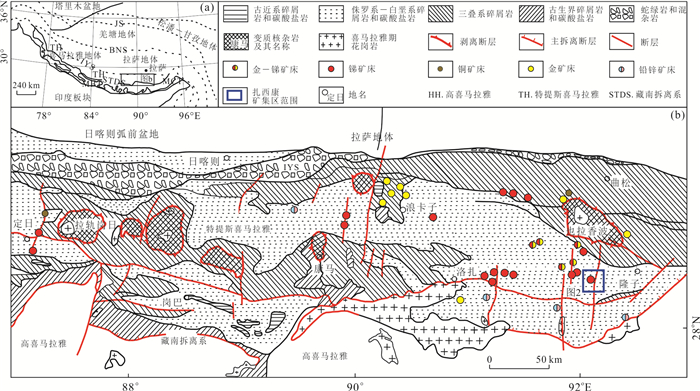
 下载:
下载:
